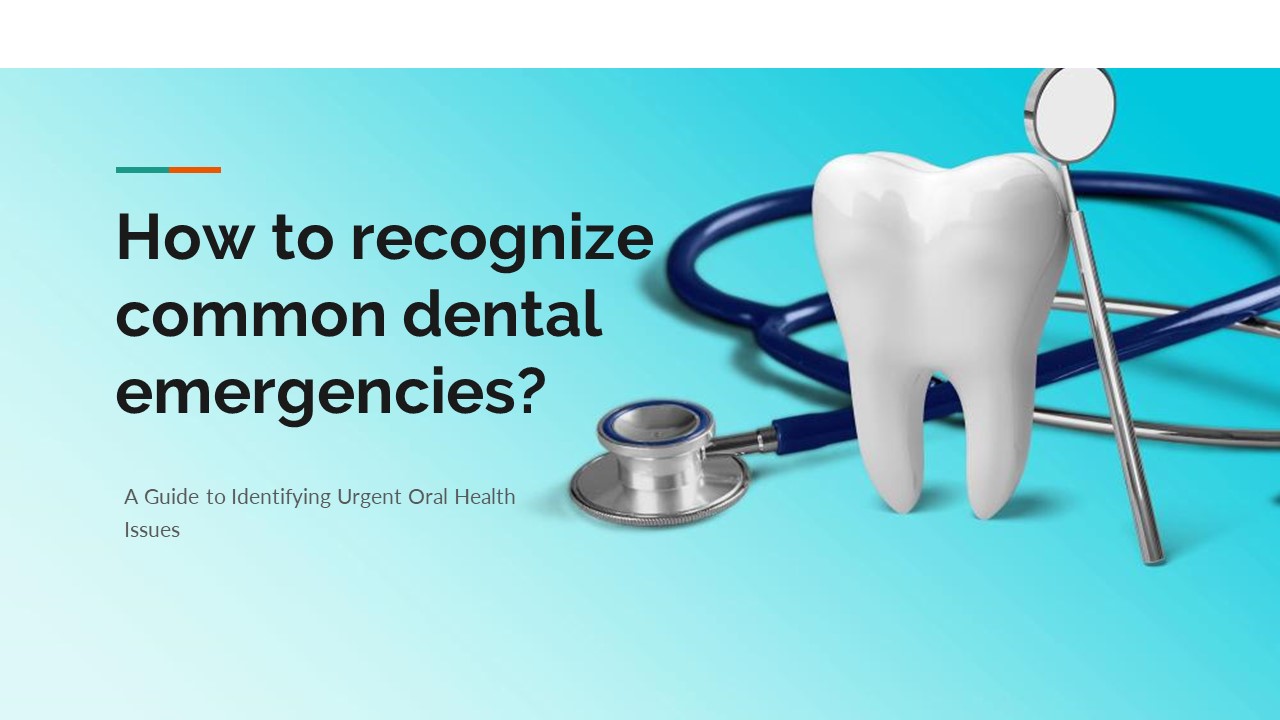How to recognize common dental emergencies? PowerPoint PPT Presentation
Title: How to recognize common dental emergencies?
1
How to recognize common dental emergencies?
- A Guide to Identifying Urgent Oral Health Issues
2
Dental emergency
- A dental emergency is any situation that requires
immediate attention from a dental professional to
save a tooth, stop bleeding, or alleviate severe
pain or infection. - Early intervention in dental emergencies can
prevent further complications, preserve oral
health, and reduce the risk of permanent damage. - This presentation will discuss common dental
emergencies, their symptoms, how to identify
them, and the appropriate actions to take.
3
Knocked-Out Tooth
- A knocked-out tooth, also known as an avulsed
tooth, occurs when a tooth is completely
displaced from its socket due to trauma or
injury. - Symptoms Pain , Bleeding , Visible tooth loss.
- Identification Empty socket, displaced tooth.
- Action Steps
- Handle the tooth by the crown, not the root, to
avoid damaging delicate tissues. - Rinse gently with milk or saliva, not water, to
remove dirt or debris. - Attempt to reinsert the tooth into the socket,
holding it in place with gentle pressure. - If reinsertion is not possible, store the tooth
in milk or saline solution to keep it moist. - Seek immediate dental care within 30 minutes for
the best chance of successful re-implantation.
4
Toothache
- A toothache is pain or discomfort in or around a
tooth, often caused by tooth decay, infection, or
trauma. - Symptoms Persistent or throbbing pain,
sensitivity to hot or cold, swelling. - Identification Pain localized to a specific
tooth or area. - Action Steps
- Rinse mouth with warm saltwater to help reduce
inflammation and clean the affected area. - Use over-the-counter pain relievers such as
ibuprofen or acetaminophen to alleviate
discomfort. - Avoid placing aspirin directly on the tooth or
gum, as it can cause irritation. - Apply a cold compress to the cheek or jaw to
reduce swelling and numb the area. - Schedule an appointment with a dentist for proper
diagnosis and treatment.
5
Broken or Chipped Tooth
- A broken or chipped tooth occurs when a portion
of the tooth's structure is fractured or
dislodged, often due to trauma or biting on hard
objects. - Symptoms Sharp or jagged edges, pain when
chewing, sensitivity. - Identification Visible damage to tooth
structure. - Action Steps
- Rinse mouth with warm water to clean the area and
remove any debris. - Save any broken pieces of the tooth if possible,
as they may be reattached by a dentist. - Cover sharp edges with dental wax or sugarless
gum to protect the tongue and cheeks. - Avoid chewing on the affected side to prevent
further damage. - Seek dental care promptly to prevent infection
and restore the tooth's function and appearance.
6
Object Stuck Between Teeth
- Objects such as food particles, dental floss, or
small foreign objects can become lodged between
teeth, causing discomfort and irritation. - Symptoms Discomfort, difficulty chewing,
bleeding gums. - Identification Visual inspection or sensation of
an object lodged between teeth. - Action Steps
- Attempt to gently remove the object using dental
floss or an interdental brush, being careful not
to push it further into the gum tissue. - Avoid using sharp or pointed objects such as
toothpicks or pins, as these can damage gums or
teeth. - If unable to remove the object, seek dental
assistance to prevent further irritation or
injury to the gums and surrounding teeth.
7
Conclusion
- Recap of key points discussed Dental emergencies
require prompt recognition and action to prevent
further complications and preserve oral health.
Knowing the symptoms and appropriate actions for
common dental emergencies can help individuals
respond effectively in urgent situations. - Importance of seeking professional dental care
for emergencies While home remedies and first
aid measures can provide temporary relief, it is
essential to seek emergency dentist help for
proper diagnosis and treatment of dental
emergencies. - Encouragement to stay informed and prepared for
dental emergencies Regular dental check-ups,
maintaining good oral hygiene habits, and having
an emergency dental kit can help individuals be
proactive in managing dental emergencies.
8
Presented By,
Dentist clifton hill

